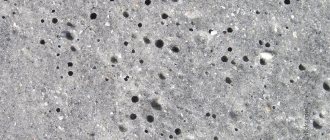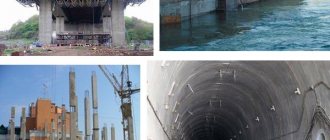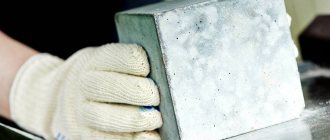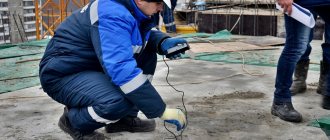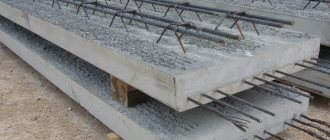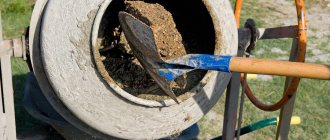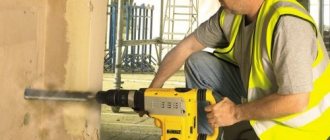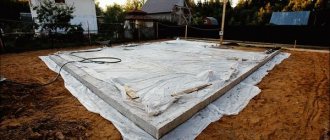The design of a building or structure involves the use of concrete of a certain grade. The concrete strength test report serves as documentary evidence of the material’s compliance with the required characteristics. It is compiled based on the results of experimental tests in a laboratory.
The importance of a concrete strength test report cannot be underestimated. This is a standard document that guarantees compliance with norms and requirements during the construction process.
Still have questions? Our specialists will be happy to help you. By clicking the button, I confirm my legal capacity and consent to the processing of my personal data in accordance with the conditions.
Concrete laboratory test report
The tests simulate special conditions that the equipment, machinery, and other objects undergoing testing must withstand. The entire procedure is recorded in the protocol. After this, the protocol is signed by the commission members or the responsible employee (the head of the organization).
The indicator at which destruction will occur is the desired value. Often, concrete is not mixed on site, but purchased from a specialized plant. Let's say you ordered a certain amount of M300 brand for an object and received the required volume.
The first condition is a distance of at least 3 centimeters between the test points, as well as 5 centimeters to the edge of the structure. This way you will save yourself from additional calculations of error and influence, and will also be able to obtain the most accurate data. The construction of residential buildings, commercial, economic and industrial structures is strictly regulated and controlled...
Protocol validity period
This document is not valid for an indefinite period. The period of its validity for mandatory examinations, established at the state level, is determined by the time the tests are carried out.
- If this is the first time , then the validity period of the document is one year ,
- for any subsequent tests , the period of relevance increases to six years .
In cases with private companies and products whose tests are carried out on the personal initiative of the organization’s management, the validity period of the protocol is determined on an individual basis.
Rules for drawing up a test report
The work is carried out in a strictly observed manner, established by the standards: GOST 12730. 1 - 78, GOST 10180 - 90, GOST 6133 - 99. The protocol may include additional information, according to individual cases.
When working with concrete, it is important to maintain the necessary humidity to prevent cracking of the pouring surface due to rapid evaporation of moisture, which also affects the quality of the material and its strength. To avoid this process, it is necessary to cover the concrete with film or other available means, and also periodically moisten the surface.
Specimens with cracks, broken edges with a depth of more than 10 mm, cavities with a diameter of more than 10 mm and a depth of more than 5 mm (except for concrete with a large-porous structure), as well as traces of delamination and undercompaction of the concrete mixture, are not subject to testing. Concrete sagging on the edges of the supporting surfaces of the samples must be removed with an abrasive stone.
Prices for testing the solution...
Research procedure
- The entrepreneur submits an application to undergo compliance confirmation procedures
- Documents for the research object and the necessary information about the product and its manufacturer are provided.
- A list of properties that will be set for the object under study is determined.
- A contract for the provision of services is concluded.
- Samples are collected and sent for laboratory testing.
- Laboratory evaluation is performed using approved methods.
- A test report is drawn up and provided to the applicant.
- Other procedures stipulated by the agreement are carried out - registration of mandatory or voluntary certificates, etc.
You can submit an application for services or obtain additional information by contacting the specialists of the certification center.
Rules for drawing up a test report
It should be noted that test results can be either positive or negative - in both cases this must be included in the protocol.
Note - When using a mirror instead of a surface plate, first check the quality of its surface. For this purpose, after setting the indicator arrows to zero, the device is shifted 10-15 mm in different directions along the surface of the mirror. Samples - cubes with dimensions of 70x70x70mm, 100x100x100mm, 150x150x150mm, 200x200x200mm (to determine the compressive strength).
K.3.1 Glued and anchored grips require special preparation of the sample during its manufacture or before testing (laying anchors or gluing the grip with glue).
Defects in welded joints that are not detected in a timely manner can lead to serious structural damage during...
The process is not complicated and training as a laboratory assistant is not required. You just need to have certain knowledge, which we will share.
Definition of the design brand. The concrete test report implies that this is one of the most important points for the entire document.
Special conical shape with stops. You can make it yourself, following the exact recommendations of the standard. But you can take a simpler route and purchase it in specialized stores.
Definition of the design brand. The concrete test report implies that this is one of the most important points for the entire document.
The document may indicate the type of building and briefly describe its features. It is necessary to disclose in detail the physical properties of each finished sample and their dimensions. Opposite each object, indicate the degree of load that was used in the experiment and the numbers obtained by the device. After this, the strength figures obtained from the formula are recorded.
Concrete structures inspection report
If this does not happen and the design strength is greater than the actual value, claims can be made against the manufacturer of the composition.
The check is carried out twice - after 7 and 28 days. Both numbers are recorded in Pascals. Moreover, on day 7 the concrete has 60-70% of its possible capacity. By day 28 it reaches 100%.
The non-destructive method involves testing with various devices without destroying the structure and losing its operational characteristics. This method allows testing directly on site and obtaining data quickly.
Special samples of concrete mortar are tested. Thus, during the construction of a building or structure, the quality of concrete is controlled. They test factory-produced and self-produced concrete.
Test methods for hardened concrete
A solution with a hardness of more than sixty is placed in a mold with a nozzle, filled to half, covered with a load with a pressure of 4X10-4 MPa, and mounted on a vibrating table. The ability of concrete to resist external influences due to internal stress depends on the composition of the solution and the brand of cement. When confirming the strength of a material corresponding to a certain brand, the sample should not show signs of destruction in the form of chips, cracks, or delamination of the structure.
The length of the traverse must be at least half the length of the sample, and its deflection under load must not be more than 1/500 of its span. The traverse is installed on the sample centrally relative to its axes and rests on the sample in two sections in thirds of the span.
Note! The frequency and volume of sampling for further testing depends on the type of structure being manufactured, compaction, exposure, driving method, and many other factors. But at least once during the manufacture of one batch of products. The technologist and the head of the laboratory establish internal regulations and procedures in accordance with which sampling is carried out.
Appendix K (recommended). Axial Tensile Testing Devices
If the material is produced at a construction site, it is collected into an ordinary tin bucket (or buckets) and taken to the laboratory urgently - until the cement laitance appears on the surface. According to the rules, of course, it is necessary for a mobile laboratory to come to the site - but what is not there is not there. Especially in small towns.
The final option depends on the type of installation. In addition to cubes, cylinders 30 cm high and 15 cm in diameter are used for testing concrete.
The most popular method, which allows one to obtain the most accurate indicators of the properties of concrete, is testing samples for compression under pressure.
The date when the samples were poured. Some other information also falls into this category. For example, it is necessary to indicate the start date of the tests. It is very important that at least 28 days pass between these two events.
Research objectives
Testing of building materials is carried out for:
- determining the possibility of putting the material into production;
- passing compliance confirmation procedures. This can be an assessment of both the concrete itself and the structures made from it;
- carrying out inspections by regulatory organizations when it is necessary to establish certain properties of a product;
- a request from a counterparty who intends to purchase material, but wants to receive accurate information about the quality characteristics of the product.
Research methods: strength characteristics and testing stages
A ruler is placed on the top of the cone so that the difference in height between the sample and the cone can be measured.
In order for practical research to be more effective, it is necessary to carry out preparatory measures. Among them is the creation of the required number of prototypes, most often presented in the form of standard cubes. The standard size of their length on one side is 20 cm. Products with 10, 15 and 30 centimeter sides are also used.
The basics of construction science tell us that concrete works great in compression and extremely poorly in tension. Let’s leave the methods of increasing the resistance of concrete for these stress groups and talk about how we can check the strength characteristics of concrete, because the main task of concrete is to be strong and durable. The strength of concrete is its ability to absorb loads and forces (tension, compression, bending, shear) and resist them due to internal stress.
8 Processing and evaluation of test results
Forms for testing concrete samples help determine the characteristics of the mixture being prepared for pouring, as well as the hardened composition.
A fairly common situation is the need to check concrete for compliance with the stated parameters. For this purpose, there are various series of tests that determine certain parameters. Most often it is necessary to determine compressive strength, but there are other important characteristics. During the execution of work, it is necessary to ensure that they are recorded in a single document.
In manufacturing companies, testing is part of routine activities. They allow you to install:
- quality of manufactured products,
- determine the degree of its suitability for further operation in various conditions, including non-standard ones,
- confirm its compliance with the declared properties.
The forms are covered with a damp cloth and stored in a room with a temperature of 20 - 22°C. After a day of such storage, the samples are removed from the molds and are marked. Before testing, the workpieces are hardened in a room with a temperature of 20–22°C and almost one hundred percent humidity.
Non-destructive testing of concrete has one very important feature, which is that we can check the strength of the structure during its operation.
A solution with a hardness of more than sixty is placed in a mold with a nozzle, filled to half, covered with a load with a pressure of 4X10-4 MPa, and mounted on a vibrating table. The vibration continues until the load settles and concrete milk appears in the cracks.
It is mandatory to check the quality of the material used during the installation of buildings and structures. To confirm compliance of the declared characteristics with design standards, concrete is tested for strength, bending and tensile strength.
Strength of concrete
Hello, dear reader of the foreman’s blog, in this article “Strength of Concrete” we will talk about the requirements at a construction site for testing concrete for strength, and find out whether tests should be carried out after 7 days. I worked in various construction companies and mostly transported concrete cubes to the laboratory 28 days after receiving the concrete mixture at the site.
I recently got a new job as a technical equipment engineer, and currently we are doing work on laying foundations for metal supports for a pipeline. To prepare construction documentation, you have to delve into all these subtleties.
At first, I took the simple route and asked the customer’s technical supervision whether it was necessary to test the concrete for strength after 7 days and attach it to the certificates. He gave an example of a construction company that worked at their factory and they tested concrete after 7 and 28 days, according to some state standard. In this article we will look at all the regulations related to concrete testing and try to find where it says about 7 days.
Theoretically, concrete gains 70% of its design strength after 7 days, and 100% after 28 days. These data are taken from various recommendations for the care of concrete, provided that it is in normal conditions (20+/-20C and humidity 95%). In reality, concrete rarely gains the specified strength, for a number of reasons due to weather conditions or improper care of the laid concrete.
I think it’s no secret that the strength of concrete for reinforced concrete structures in buildings is calculated by designers. Based on the project data, concrete is ordered (for pouring it into foundations, walls, columns, floor slabs, etc.) from a plant of a certain brand, with a given frost resistance, water resistance, mobility, etc.
At the construction site, the plant must provide the foreman or responsible person with a quality certificate for the concrete mixture, which indicates the concrete grade, mobility, additives and volume. Usually, with each mixer, a document for the concrete mixture is sent, and this data is entered into the concrete work log.
But how do we know that the concrete plant brought to the construction site exactly the mixture that we ordered? For this purpose, concrete tests are carried out after the estimated time of strength gain, usually 28 days. First of all, these tests are needed by builders; if the strength does not correspond to the ordered concrete, then the costs of dismantling can be charged to the concrete plant.
Concrete is tested by several methods in accordance with GOST R 53231-2008 “CONCRETE. Rules for monitoring and assessing strength":
3.14 destructive methods for determining the strength of concrete: Determination of the strength of concrete using control samples made from a concrete mixture in accordance with GOST 10180 or selected from structures in accordance with GOST 28570.
3.15 direct non-destructive methods for determining the strength of concrete, which do not require mandatory calibration: Determination of the strength of concrete by “tearing with shearing” and “rib shearing” according to GOST 22690.
3.16 indirect non-destructive methods for determining the strength of concrete: Methods for determining the strength of concrete using pre-established calibration relationships between the strength of concrete, determined by one of the destructive or direct non-destructive methods, and indirect strength characteristics determined according to GOST 22690 and GOST 17624.
In this article we will deal with the destructive method, using control samples, and the production of concrete cubes. Now it’s winter and the non-destructive method cannot be applied according to GOST 22690-88 “CONCRETE. Determination of strength by mechanical methods of non-destructive testing":
1.3. Mechanical non-destructive testing methods are used to determine the strength of concrete of all types of standardized strength, controlled according to GOST 18105-86, as well as to determine the strength of concrete during inspection and rejection of structures.
The test method should be selected taking into account the maximum strength values recommended by the manuals for specific non-destructive testing devices, in accordance with the requirements of Section. 3 of this standard.
(Revised, Amendment 2009)
1.4. Tests are carried out at positive concrete temperatures . When examining structures, it is allowed to determine the strength at a negative temperature, but not lower than minus 10 °C, provided that at the time of freezing the structure was at least one week at a positive temperature and a relative air humidity of no more than 75%.
I wonder how long it takes for your construction site to heat the poured concrete in the winter? A day, two, three or a week. Working in various construction organizations, we heated concrete everywhere, mostly for no more than two days. So, according to GOST 22690-88, it is impossible to test concrete for strength in winter using a non-destructive method.
In the laboratory, concrete is tested for strength by pressing concrete cubes measuring 10 by 10 cm in a press. Special metal molds are used to make concrete cubes at construction sites.
It happened to me that there was no iron mold at the construction site and we made it from formwork plywood. The disadvantage of this homemade form is that the cubes are not perfectly even and the laboratory did not accept them.
If you use regular plywood for the form, then you need to put plastic film inside so that the concrete does not come into contact with the plywood and does not lose moisture. Before placing the concrete mixture in an iron mold, it is necessary to lubricate the inside of it with machine oil, so that the cubes can then be easily removed from the mold and it remains clean.
How to take concrete samples for the laboratory can be found in GOST 10181-2000 “CONCRETE MIXTURES. Test methods".
3 Rules for sampling and testing
3.1 Concrete mixture samples for testing during production control should be taken:
- in the production of prefabricated and monolithic products and structures - at the site of laying the concrete mixture;
- when dispensing ready-mix concrete - at the place of its preparation when loading into a transport container.
3.2 A sample of the concrete mixture for testing is taken immediately before the start of concreting from the middle part of the batch or portion of the mixture. With a continuous supply of concrete mixture (belt conveyors, concrete pumps), samples are taken in three steps at random times for no more than 10 minutes.
3.3 The volume of the sample taken must provide at least two determinations of all controlled indicators of the quality of the concrete mixture.
3.4 The selected sample must be additionally mixed before testing.
Concrete mixtures containing air-entraining, gas-forming and foam-forming additives, as well as preheated mixtures, are not mixed before testing.
3.5 Testing the concrete mixture and making control samples of concrete should begin no later than 10 minutes after sampling.
3.6 The temperature of the concrete mixture from the moment of sampling to the end of the test should not change by more than 5 °C.
3.7 The storage conditions for the concrete mixture sample after its collection until testing must prevent loss of moisture or wetting.
3.8 Verification of measuring instruments and certification of testing equipment should be carried out in accordance with GOST 8.001, GOST 8.326, GOST 8.383.
3.9 The results of determining the quality indicators of the concrete mixture must be entered in a journal in which they indicate:
— name of the organization producing the mixture;
— name of the concrete mixture according to GOST 7473;
— name of the quality indicator being determined;
— date and time of testing;
— sampling location;
— temperature of the concrete mixture;
— results of partial determinations of individual indicators of concrete mix quality and arithmetic average results for each indicator.
If you score the cubes incorrectly and use a homemade form, then most likely the laboratory will not accept your samples for testing. For an example of a bad concrete cube, which was made in a homemade form from plywood and was not pierced (not vibrated), see the picture.
I also described how to make concrete cubes correctly in the article “Vibrating Concrete.”
We have sorted out the concrete samples for the laboratory, but the question remains open whether concrete should be tested for strength after 7 days, maybe the answer will be found in SNiP 3.03.01-87 “LOAD-LOADING AND ENCLOSING STRUCTURES”, but apart from this entry nothing else is written:
TESTING OF CONCRETE DURING ACCEPTANCE OF STRUCTURES
2.18. Strength, frost resistance, density, water resistance, deformability, as well as other indicators established by the project, should be determined in accordance with the requirements of current state standards.
It is not clear in which GOSTs to look for answers, we continue to search further. We read SP 52-101-2003 clause 5.1.4 “CONCRETE AND REINFORCED CONCRETE STRUCTURES WITHOUT PRE-STRESSING REINFORCEMENT”:
5.1.4 The age of concrete corresponding to its class in terms of compressive and axial tensile strength (design age) is assigned during design based on the possible real terms of loading structures with design loads. In the absence of this data, the concrete class is established at the age of 28 days.
It turns out that if the project does not indicate that the strength of concrete after 7 days should be equal to some value, then concrete cubes should not be taken to the laboratory for strength testing and the desire of technical supervision can be answered with a refusal.
How we took the cubes to the laboratory to test the strength of concrete.
Yes, first of all, testing of concrete for strength is necessary for the builders, and not for the customer, so that in case something happens they do not remain on the extreme side. In reality, everything happens the other way around, deadlines come first, the customer rushes the contractor, and they remember about the as-built documentation when they have worked for 1-2 months.
And then the builders remember that during pouring they did not make concrete cubes and in general there were no metal forms at the construction site. I have often found myself in such a situation; often concrete cubes simply got lost.
In such cases, we simply took and made the required number of cubes from a concrete mixer that came to the site, and it didn’t matter that we had to test the concrete a month ago. The main thing is to sign certificates of completed work in order to receive money.
If control at a construction site is strict and there are no concrete cubes, then a laboratory is called to the site and the concrete is tested using an indestructible method, or cores are cut out of the concrete structure using diamond drilling and taken for testing.
I will be glad to see your additions in the comments on the topic of testing concrete for strength.
Sincerely, Oleg Klyshko

